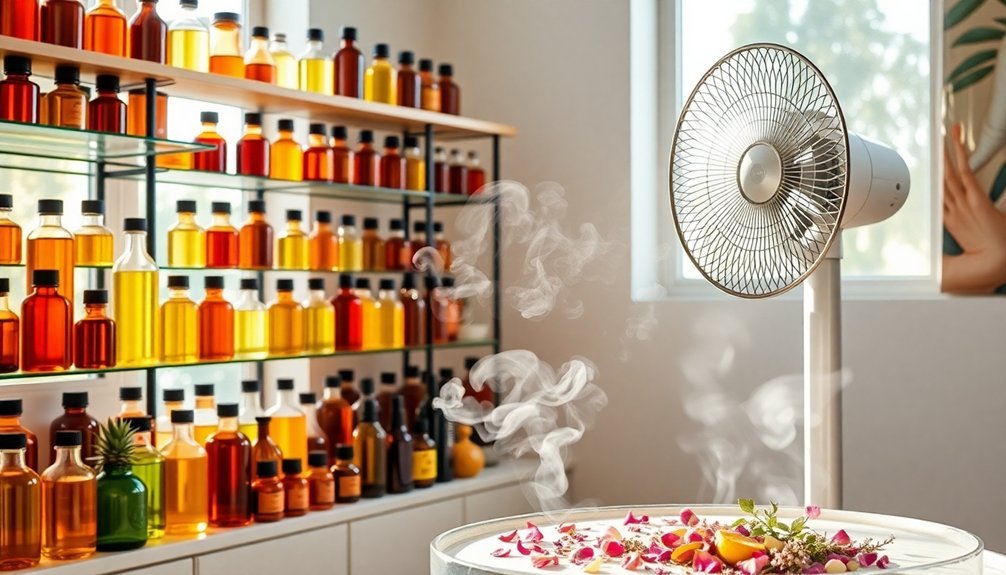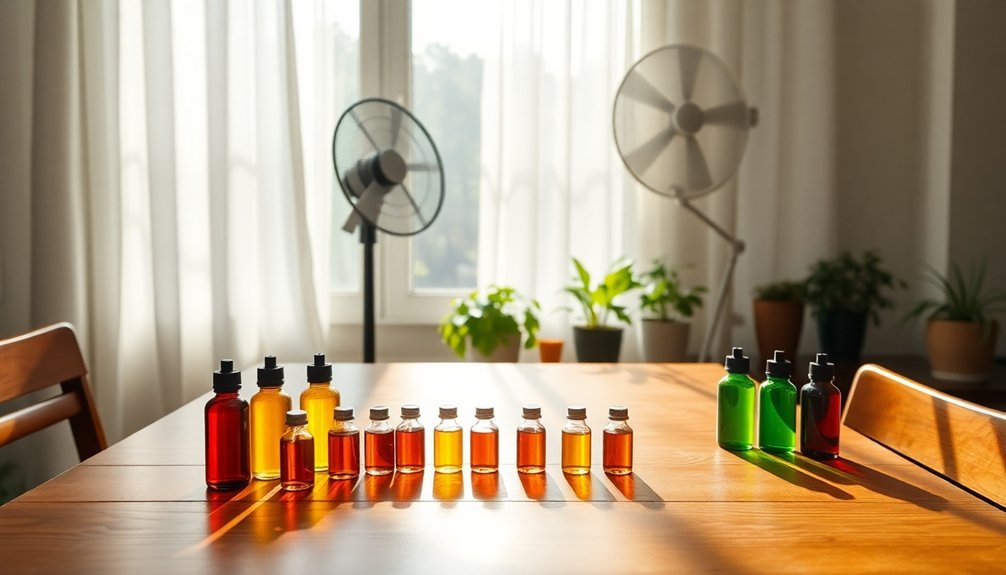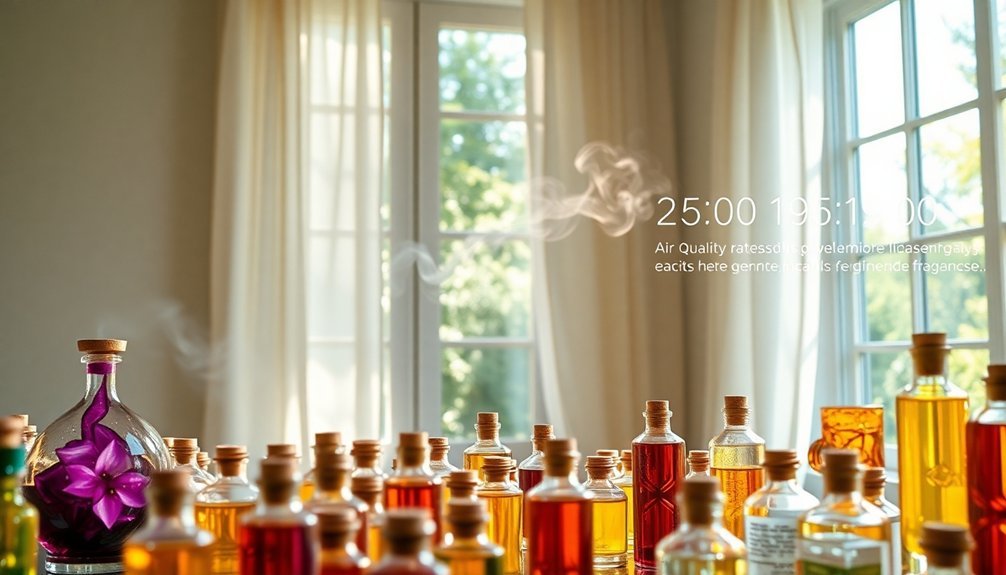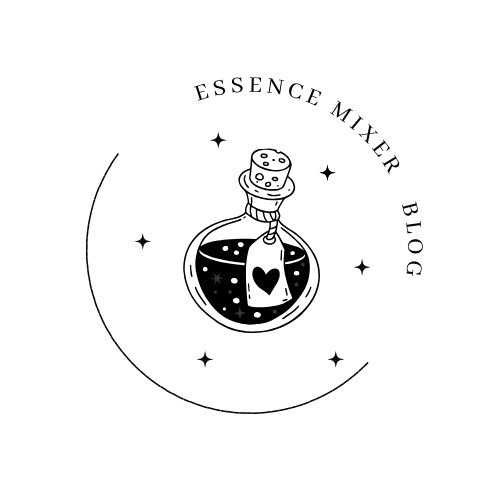To safely blend fragrances, you'll need proper ventilation that includes both natural and mechanical airflow. Set up an exhaust fan near your blending station, keep windows open, and use an air purifier with activated carbon filters to remove VOCs and odors. Position fans strategically to disperse vapors, and take hourly breaks outdoors. Understanding these basics will help protect your health, but there's much more to creating a superior blending environment.
Understanding Basic Ventilation Requirements

When working with fragrance oils, proper ventilation is vital to protect your health and maintain a safe blending environment.
You'll need to guarantee your workspace has adequate air circulation to prevent the accumulation of fragrance oil fumes that could cause breathing difficulties.
Start by opening windows and using exhaust fans to create consistent airflow throughout your blending area. If you're working in a confined space, consider installing an air purifier with activated carbon filters to remove airborne particles and strong odors.
It's also important to take regular breaks outdoors to avoid extended exposure to concentrated scents. Keep your workspace tidy and organized, as this helps maintain better air quality and prevents unwanted scent mixing.
Natural Vs Mechanical Airflow Systems
Although both natural and mechanical ventilation systems serve important roles in fragrance blending, each offers distinct advantages for your workspace.
Natural airflow systems provide a gentle, cost-effective solution through open windows and doors, while mechanical airflow systems deliver consistent, controlled circulation regardless of weather conditions.
Here's what proper ventilation can do for your blending experience:
- Create a safer environment by dispersing potentially harmful VOCs
- Help you maintain a clear head while working with potent fragrances
- Protect your precious ingredients from environmental contamination
- Enhance your ability to accurately assess scent combinations
- Provide peace of mind knowing you're working in ideal conditions
For best results, consider combining both ventilation methods.
You'll benefit from the natural freshness of outdoor air while maintaining reliable air quality through mechanical filtration and circulation.
Setting Up Your Blending Workspace

Your fragrance blending workspace requires essential ventilation equipment like an exhaust fan and air purifier to maintain safe air quality while you work with potent oils.
You'll need to position these ventilation tools strategically by placing the exhaust fan near your blending station and the air purifier in a corner where it can effectively filter the entire room.
Set up your workspace away from living areas and food preparation zones, keeping your blending materials organized on a stable surface with clear access to windows or ventilation points.
Basic Ventilation Equipment Needs
Proper ventilation forms the backbone of a safe and comfortable fragrance blending workspace.
To create blends effectively, you'll need essential equipment that blend well together to protect your health and maintain air quality. It's a good idea to invest in basic ventilation tools before starting your fragrance journey.
- A window that opens fully to provide natural airflow and fresh air exchange
- A high-quality air purifier with activated carbon filters to capture airborne particles
- An exhaust fan to actively remove strong scents and chemical vapors
- A professional-grade mask designed specifically for working with fragrance oils
- A fume hood or dedicated ventilation system for larger-scale blending projects
Position your equipment strategically to maximize air circulation and create a workspace that protects your respiratory health while allowing creative freedom in your fragrance work.
Safe Workspace Layout Tips
Setting up a dedicated workspace for fragrance blending requires careful consideration of both safety and functionality.
When planning your safe workspace layout tips, make certain to designate an area away from your main living spaces to protect family members and pets from potential fragrance sensitivities.
Position your blending station near windows or install exhaust fans to guarantee proper ventilation of fragrance oil fumes.
You'll want to blend together your oils in a well-lit area that allows you to see measurements clearly and avoid spills.
Keep your safety equipment, including gloves and goggles, within arm's reach for quick access.
Organize your workspace with clearly labeled containers and tools to prevent mistakes.
This systematic arrangement helps maintain efficiency while prioritizing safety throughout your blending process.
Safety Measures for Indoor Fragrance Work
When working with fragrance oils indoors, maintaining proper ventilation stands as the cornerstone of a safe blending environment.
Even small amounts of pure essential oils can release strong fumes, making a safe breathing environment essential for your well-being. You'll need to prioritize air circulation and protection while working with these potent materials.
- Keep windows open to let fresh air flow through your workspace
- Position fans strategically to disperse fragrance vapors effectively
- Install an air purifier with activated carbon filters to trap airborne chemicals
- Stay away from heat sources to prevent dangerous vapor accumulation
- Take outdoor breaks every hour to refresh your lungs and clear your head
Remember to maintain distance from your blending station and never work in confined spaces where fumes can concentrate to unsafe levels.
Proper Air Exchange Rates and Standards

Air exchange rates play an essential role in creating a safe fragrance blending environment. You'll need to maintain 6-15 air changes per hour to effectively manage VOCs released during your blending process. Monitor your indoor air quality to keep VOC levels below 500 µg/m³, ensuring your workspace remains healthy and safe.
| Parameter | Recommended Standard |
|---|---|
| Air Changes/Hour | 6-15 exchanges |
| Maximum VOC Level | 500 µg/m³ |
| Ventilation Method | Exhaust fans + windows |
| Air Filtration | Activated carbon filters |
To achieve these standards, you'll want to combine natural ventilation through open windows with mechanical systems like exhaust fans. Adding an air purifier with activated carbon filters will help capture lingering VOCs and other airborne compounds, giving you an extra layer of protection during your fragrance work.
Equipment and Tools for Adequate Ventilation
To create a safe fragrance blending environment, you'll need several essential ventilation tools. Whether you're working with delicate top notes or lingering base notes, proper airflow is vital for your safety and comfort.
- A dedicated workspace with operable windows for natural air circulation
- A professional-grade fume hood to extract concentrated vapors
- High-quality air purifiers with activated carbon filters
- Chemical-resistant face masks designed specifically for fragrance work
- An exhaust fan system to maintain consistent air movement
These tools work together to protect you from VOCs and maintain air quality while you blend.
Position your equipment strategically to create ideal airflow patterns, and don't forget to regularly maintain your air purifiers and exhaust systems.
Remember to step outside periodically for fresh air breaks, especially when working with intense fragrances for extended periods.
Frequently Asked Questions
How Do You Blend Fragrances?
Start with single drops of fragrance oils using a dropper, test on perfume strips, and document your combinations. Let scents meld for 15-20 seconds, then evaluate and adjust until you've created your desired blend.
Is Perfume Considered a Voc?
Yes, perfume is classified as a VOC because it contains organic chemicals that'll evaporate at room temperature. You'll find these compounds can contribute to indoor air pollution and may cause respiratory irritation.
How Do You Spread Fragrance in a Room?
You can spread fragrance using an essential oil diffuser, lighting scented candles, placing potpourri around the room, or spraying room fresheners. Don't forget to maintain good airflow for better scent distribution throughout your space.
What Is the Ratio for Blending Perfume?
You'll want to start with a 30-50-20 ratio: 30% top notes, 50% middle notes, and 20% base notes. Use a dropper for precise measurements and let your blend rest for 48 hours before testing.
In Summary
Proper ventilation while blending fragrances isn't just a luxury – it's vital for your health and safety. You'll need to guarantee your workspace has both adequate air exchange and filtration systems in place. Whether you choose natural ventilation through windows or mechanical systems like exhaust fans, don't compromise on this critical aspect. Remember, you're working with concentrated substances that require careful handling and appropriate airflow management.





Leave a Reply